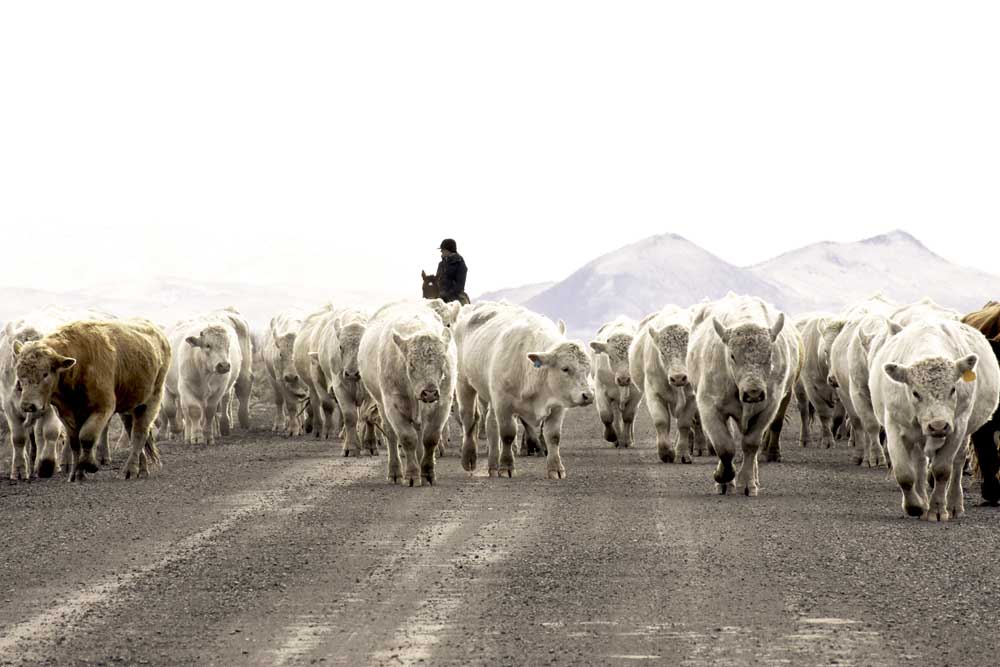Weekend Break: The Desert in Winter
Published 9:00 am Saturday, February 22, 2020

- A herd of steers takes over a road near Alvord Lake in southeast Oregon.
Desert. The word itself makes my lips feel sandy and salty, and my hands dry. My hair blows even though the wind is calm.
Trending
I have long ventured to Oregon’s desert in the spring to experience the fantastic blooms and the warmer breezes that grace the state’s southeastern corner.
I have rarely ventured there for a stay in the winter. Inspired by my colleague David Campiche’s experience at the Alvord Desert, I set off to get a feel for winter desert life.
When prepping for the trip I found that the term “desert” is relative. As one High Desert Museum docent says, the definition of desert “depends on who you talk to.”
Trending
Much of Oregon east of the Cascade mountains is popularly known as the High Desert. Only a small portion of that acreage is considered true desert.
A desert is defined as a place that experiences less than 10 inches of precipitation per year. Oregon has a significant amount of acreage that fits the model. Most of that lies in Malheur, Harney and Lake counties, with smaller acreages in Deschutes, Crook and Jefferson counties. A large portion of Gilliam, Morrow and Umatilla counties bordering the Columbia River are classified as true deserts.
As I steer my old Volkswagen bus down U.S. Highway 197 into Maupin, prospective images of deserts excite me.
As I exit the bus, I give a cursory look to the tires and notice that the right rear is low. When you drive as many miles on gravel roads as I do, it is always a possibility. The only auto service in sight is Richmond’s Service, a 1940s roadside station that evokes old movie vibes.
The place is operated by owner Rodney Woodside. After a few VW bus stories and a cup of coffee, Woodside takes pity on me and has the flat fixed in a half hour.
Soon I’m back on the road. The sun is warm. I’m through Bend in no time and headed east on U.S. Highway 20. The sun slowly sets in the west behind me. In an hour it is 30 degrees. I press on for another two hours until reaching a spot near the junction of U.S. Route 395 for a warm snooze under 10 inches of layers.
At around 4:30 a.m., I reach for the flashlight and look at the clock and thermometer. It is now six degrees inside the bus.
I pull the blankets back over my head and rue the morning. At dawn, I jump out like a flash and start the bus, which is fighting back. But nevertheless, old faithful starts.
I begin scraping ice inside and out. About an hour later I pull into a truck stop in Burns where I eat breakfast and get my bearings for a desert cruise and photoshoot. It is now 15 degrees. The wind blows about 25 mph.
Since I wanted to get a taste of varying true-desert environments and many of those are available near Burns, it’s a good place for home base. Burns is the picture of a high desert town at the junction of three major highway thoroughfares. It’s the economic and commercial center of southeast Oregon.
Burns just misses the true-desert designation with 10.57 inches of precipitation annually. Although Harney County is known as a ranch county, management and administrative jobs are more common.
Malheur Lake and Mud Lake are remnants of a large Pleistocene era lake that covered much of southeast Oregon. In winter the lakes are relatively birdless except for some common ravens, an occasional great horned owl and a few resident ducks and trumpeter swans. Average precipitation is around nine inches per year.
I cruise the roads near the lakes trying to see more wildlife but there isn’t much to see since most birds migrate, and desert floor dwelling animals are underground.
Smaller mammals and reptiles in the high desert don’t technically hibernate but they enter a state of rest where they reduce 90% of their energy output. This means that even though they are mainly underground-based, they are at-large enough to provide prey for foxes, coyotes, lynx, owls and falcons. One that makes me shiver is the pygmy short-horned lizard. This little reptile buries itself in the sand an inch or so and freezes solid for sometimes months at a time.
As I turn onto East Steens Road the wind picks up to 20 mph. At 20 degrees it is cold to get out of the bus to take photos. Thanks to my down attire, I am able to staunch the cold.
The valley and lower slopes of the mountain are Sage and Savannah type deserts, like most of the land east of the Cascades and much of the west.
Big sagebrush and rabbitbrush, along with hardy grasses such as blue bunchgrass and wheatgrass predominate. Geologic activity is evidenced by hot springs dotted throughout the region.
Approaching the Alvord Lake area and the Alvord Desert, I encounter something many would think has disappeared in the American West, a cattle drive. At first, just a man on horseback comes toward me on the road with two border collies.
Then, as I round the corner, a white wave of Charolais steers come plodding slowly down the road, driven by three cowboys, one cowgirl and more cow dogs.
I stop dead at the side while the animals amble past. This would make a great photograph, my old blue bus surrounded by a sea of white critters, but I’m not about to upset the herd.
As I move south toward Fields, the extremely flat, pinky-gray surface of the Alvord Desert playa appears empty. From my position on a rock high above, I see the entire valley.
No vehicles, no animals, no humans. Nothing moves. The desert rests, as it is winter, waiting for the explosion of spring. The wind has calmed. The silence is deafening. I too have calmed.
Scientific names of desert environments
Subtropical — Caused by a wind current emanating from the tropics. The Sahara Desert and Kalahari Desert in Africa are examples.
Coastal — Cold air currents from the ocean help create coastal deserts. Atacama Desert in western Chile is an example.
Rain shadow — Formed on the leeward slopes of large mountains. Death Valley Desert and the Oregon High Desert are examples.
Interior — Found in the heart of continents far from oceans. The Gobi Desert in Mongolia and China are examples.
Polar — Cold deserts with limited moisture. All of Antarctica and parts of the Arctic are polar deserts.









